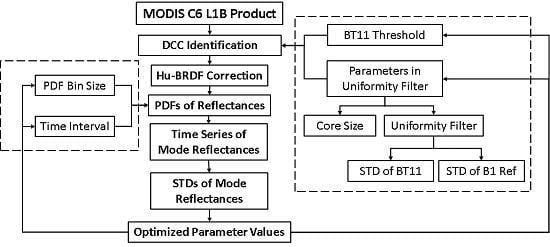Optimization of a Deep Convective Cloud Technique in Evaluating the Long-Term Radiometric Stability of MODIS Reflective Solar Bands
Abstract
:1. Introduction
2. Methodology
2.1. Background
2.2. Identification of Deep Convective Clouds
2.3. Derivation of Reflectance Trending Using the DCC Technique
3. Sensitivity Tests
3.1. PDF Bin Interval
3.2. Data Collection Time Interval Effects
3.3. Effects from Parameters in the Uniformity Test
3.3.1. Core Size Extent Impact on the Uniformity Filter
3.3.2. Criteria for Spatial Standard Deviations of Brightness Temperature and 0.65-µm Reflectance in the Uniformity Test
3.4. Brightness Temperature Threshold Effects
3.4.1. Monthly Frequency of DCC Pixels Reflectance versus BT11
3.4.2. Optimal Brightness Temperature Threshold
- (1)
- The magnitudes of monthly mode reflectances vary for different RSB. The mode reflectances are low for RSB 6–7, around 0.24 for RSB 6 and around 0.13 for RSB 7. The mode reflectances are at about the same level for RSB 5 and 26, around 0.67 for RSB 5 and around 0.6 for RSB 26. The highest mode reflectances are with RSB 1, 3–4 and 18, above 0.85. Therefore for the same absolute STD variation across all MODIS RSB, RSB 6–7 would have a larger relative STD change than the relative STD change for RSB 5 and 26, and RSB 1 and 3–4 would have the smallest relative STD change (Figure 12).
- (2)
- Reflectance is most sensitive to the particle size in clouds at wavelengths near 1.63 µm (RSB 6), 2.11 µm (RSB 7), then at wavelengths near 1.24 µm (RSB 5) and 1.38 µm (RSB 26) [32]. The ice particle size in the DCCs changes with brightness temperature [31]. The difference in reflectance responses to particle size derives great sensitivity of RSB to BT11 thresholds for the SWIR bands.
3.5. Optimized DCCT Parameters
4. Comparisons between the Uncertainty Errors Using the Optimized DCC Technique, Desert and Dome-C Observations
5. Conclusions
- 1
- The bin size in the histogram processing has minimal impact on the stability of the DCC technique. The largest impact is on the SWIR bands 6–7, and the difference in the STDs compared to those from the baseline is less than 20%. Based on the magnitude of the STDs and the stability of the trends against bin size, the optimal bin size value is set as 0.002 for RSB 1, 3–5, 18, and 26, and 0.001 for RSB 6–7.
- 2
- The BRDF correction model designed by Hu et al. (2004) for the VIRS at wavelength of 0.65 µm is applied to the results using the baseline method for all channels. For wavelengths less than 1 µm, the Hu model reduces the trend uncertainty. However, for the SWIR channels, the Hu model is inadequate and may increase the trend standard error.
- 3
- Increasing the time interval from one month to a year can reduce the intrinsic seasonality and the uncertainty error in the DCCT results. The seasonal cycle is small for RSB with wavelengths less than 1 µm and larger for RSB with longer wavelengths. The seasonal cycle of DCC properties mostly affects the SWIR bands that are impacted by cloud microphyiscs. For long-term evaluation of the performance of MODIS calibrations, the minimal time interval of 3, or 6, or 12 months are recommended. However, for operational stability monitoring purposes, monthly time interval is recommended as the optimal data collection time in the future standard MCST operational DCC technique. If the user has a requirement for an uncertainty less than a certain value, Figure 5 can provide the smallest temporal interval to achieve the uncertainty required.
- 4
- The uniformity test parameters of the BT11 STD, the RSB 1 reflectance STD and the spatial extent used to compute the STD play an important role in the DCCT to exclude the heterogeneous DCC samples. The criteria of BT11 STD and RSB 1 reflectance STD as 1 K and 3%, or 1 K and 5%, respectively, are recommended as optimal uniformity filter thresholds for the MODIS performance monitoring using DCCT. Using larger core sizes results in actual DCCs with higher uniformity, but shrinks the number of the DCC samples and reduces the smoothness of the PDFs. By balancing the core size with sampling frequency, a core size of 5 by 5 for RSB 1, 3–4 and 18 and 3 by 3 for RSB 5–7 and 26 is recommended in the uniformity test.
- 5
- The DCC technique is most sensitive to the BT11 threshold in the DCC identification. Increasing the BT11 thresholds can increase the DCC sampling, leading to more predictable PDF shapes and therefore more stable mode reflectances. However, DCCs identified using lower BT11 thresholds are more likely to be associated with convective cores than those using greater BT11 thresholds. As a result, the trend uncertainties will decrease with increasing BT11 and remain constant between 205 K and 210 K. This does not hold true for band 26 and 18, for which the trend uncertainty starts increasing rapidly when BT11 is greater than 205 K. With increasing BT11 thresholds, lower and warmer cirrus clouds are misidentified as DCCs. The water vapor column above them strongly affects the reflectance of RSB 26 and 18, and hence induces larger uncertainties [32,34]. BT11 threshold is recommended between 203 and 205 K for all of the studied Terra and Aqua RSB.
Author Contributions
Conflicts of Interest
References
- Xiong, X.; Sun, J.; Barnes, W.; Salomonson, V.; Esposito, J.; Erives, H.; Guenther, B. Multi-year On-orbit Calibration and Performance of Terra MODIS Reflective Solar Bands. IEEE Trans. Geosci. Remote Sens. 2007, 45, 879–889. [Google Scholar] [CrossRef]
- Xiong, X.; Wenny, B.; Barnes, W. Overview of NASA Earth Observing Systems Terra and Aqua Moderate Resolution Imaging Spectroradiometer Instrument Calibration Algorithms and On-orbit Performance. J. Appl. Remote Sens. 2009, 3, 032501. [Google Scholar] [CrossRef]
- Xiong, X.; Sun, J.; Xie, X.; Barnes, W.; Salomonson, V. On-Orbit Calibration and Performance of Aqua MODIS Reflective Solar Bands. IEEE Trans. Geosci. Remote Sens. 2010, 48, 535–546. [Google Scholar] [CrossRef]
- Sun, J.; Xiong, X.; Barnes, W.; Guenther, B. MODIS Reflective Solar Bands On-Orbit Lunar Calibration. IEEE Trans. Geosci. Remote Sens. 2007, 45, 2383–2393. [Google Scholar] [CrossRef]
- Sun, J.; Xiong, X. Solar and lunar observation planning for Earth-observing sensor. SPIE Remote Sens. 2011. [Google Scholar] [CrossRef]
- Sun, J.; Xiong, X.; Angal, A.; Chen, H.; Wu, A.; Geng, X. Time-Dependent Response Versus Scan Angle for MODIS Reflective Solar Bands. IEEE Trans. Geosci. Remote Sens. 2014, 52, 3159–3174. [Google Scholar] [CrossRef]
- Xiong, X.; Cao, C.; Chander, G. An Overview of Sensor Calibration Inter-comparison and Applications. Front. Earth Sci. China 2010, 4, 237–252. [Google Scholar] [CrossRef]
- Xiong, X.; Wu, A.; Wenny, B.; Choi, J.; Angal, A. Progress and Lessons from MODIS Calibration Inter-comparison Using Ground Test Sites. Can. J. Remote Sens. 2010, 36, 540–552. [Google Scholar] [CrossRef]
- Wu, A.; Xiong, X.; Cao, C. Examination of Calibration Performance of Multiple POS Sensors Using Measurements over the Dome C Site in Antarctica, Sensors, Systems, and Next Generation Satellites XII. SPIE Remote Sens. 2008. [Google Scholar] [CrossRef]
- Wu, A.; Xiong, X.; Doelling, D.R.; Morstad, D.; Angal, A.; Bhatt, R. Characterization of Terra and Aqua MODIS VIS, NIR, and SWIR Spectral Bands’ Calibration Stability. IEEE Trans. Geosci. Remote Sens. 2013, 51, 4330–4338. [Google Scholar] [CrossRef]
- Kwiatkowska, E.J.; Franz, B.A.; Meister, G.; McClain, C.R.; Xiong, X. Crosscalibration of Ocean-Color Bands from Moderate-Resolution Imaging Spectrometer on Terra Platform. Appl. Opt. 2008, 47, 6796–6810. [Google Scholar] [CrossRef] [PubMed]
- Meister, G.; McClain, C.R. Point-spread function of the ocean color bands of the Moderate Resolution Imaging Spectroradiometer on Aqua. Appl. Opt. 2010, 49, 6276–6285. [Google Scholar] [CrossRef] [PubMed]
- Doelling, D.R.; Morstad, D.; Scarino, B.R.; Bhatt, R.; Gopalan, A. The characterization of deep convective clouds as an invariant calibration target and as a visible calibration technique. IEEE Trans. Geosci. Remote Sens. 2013, 51, 1147–1159. [Google Scholar] [CrossRef]
- Doelling, D.R.; Wu, A.; Xiong, X.; Scarino, B.R.; Bhatt, R.; Haney, C.O.; Morstad, D.; Gopalan, A. The radiometric stability and scaling of collection 6 Terra- and Aqua-MODIS VIS, NIR, and SWIR spectral bands. IEEE Trans. Geosci. Rem. Sens. 2015, 53, 4520–4535. [Google Scholar] [CrossRef]
- Doelling, D.R.; Nguyen, L.; Minnis, P. On the use of deep convective clouds to calibrate AVHRR data. In Proceedings of the Optical Science and Technology, the SPIE 49th Annual Meeting, International Society for Optics and Photonics, Denver, CO, USA, 2–6 August 2004. [Google Scholar]
- Doelling, D.R.; Morstad, D.L.; Bhatt, R.; Scarino, B. Algorithm Theoretical Basis Document (ATBD) for Deep Convective Cloud (DCC) Technique of Calibrating GEO Sensors with Aqua-MODIS for GSICS, GSICS. Available online: http://gsics.atmos.umd.edu/pub/Development/AtbdCentral/GSICS_ATBD_DCC_NASA_2011_09.pdf (accessed on 27 May 2017).
- Aumann, H.H.; Pagano, T.; Hofstadter, M. Observations of deep convective clouds as stable reflected light standard for climate research: AIRS evaluation. SPIE 2007. [Google Scholar] [CrossRef]
- Fougnie, B.; Bach, R. Monitoring of radiometric sensitivity changes of space sensors using deep convective clouds: Operational application to PARASOL. IEEE Trans. Geosci. Remote Sens. 2009, 47, 851–861. [Google Scholar] [CrossRef]
- Chang, T.; Xiong, X.; Angal, A.; Mu, Q. Assessment of MODIS RSB detector uniformity using deep convective clouds. J. Geophys. Res. Atmos. 2016, 121, 4783–4796. [Google Scholar] [CrossRef]
- Mu, Q.; Wu, A.; Chang, T.; Angal, A.; Link, D.; Xiong, X.; Doelling, D.R.; Bhatt, R. Assessment of MODIS on-orbit calibration using a deep convective cloud technique. In Proceedings of the SPIE 9972, Earth Observing Systems XXI, San Diego, CA, USA, 28 August–1 September 2016. [Google Scholar]
- Bhatt, R.; Doelling, D.R.; Angal, A.; Xiong, X.; Scarino, B.; Gopalan, A.; Haney, C.O.; Wu, A. Characterizing response versus scan-angle for modis reflective solar bands using deep convective clouds. J. Appl. Remote Sens. 2016, 11, 016014. [Google Scholar] [CrossRef]
- Li, Y.; Wu, A.; Xiong, X. Evaluating Calibration of MODIS Thermal Emissive Bands Using Infrared Atmospheric Sounding Interferometer Measurements. Proc. SPIE 2013, 8724. [Google Scholar] [CrossRef]
- Hu, Y.B.; Wielicki, B.A.; Yang, P.; Stackhouse, P.W., Jr.; Lin, B.; Young, D.F. Application of deep convective cloud albedo observation to satellite-based study of the terrestrial atmosphere: Monitoring the stability of spaceborne measurements and assessing absorption anomaly. IEEE Trans. Geosci. Remote Sens. 2004, 42, 2594–2599. [Google Scholar]
- Tian, B.; Soden, B.J.; Wu, X. Diurnal cycle of convection, clouds, and water vapor in the tropical upper troposphere: Satellites versus a general circulation model. J. Geophys. Res. 2004, 109, D10101. [Google Scholar] [CrossRef]
- Hong, G.; Heygster, G.; Miao, J.; Kunzi, K. Detection of tropical deep convective clouds from AMSU-B water vapor channels measurements. J. Geophys. Res. 2005, 110, D05205. [Google Scholar] [CrossRef]
- Liu, C.; Zipser, E.J.; Nesbitt, S.W. Global distribution of tropical deep convection: Different perspectives from TRMM infrared and radar data. J. Clim. 2007, 20, 489–503. [Google Scholar] [CrossRef]
- Wang, W.; Cao, C. DCC radiometric sensitivity to spatial resolution, cluster size, and LWIR calibration bias based on VIIRS observations. J. Atmos. Ocean. Technol. 2015, 32, 48–60. [Google Scholar] [CrossRef]
- Chang, T.; Xiong, X.; Mu, Q. VIIRS Reflective Solar Band Radiometric and Stability Evaluation Using Deep Convective Clouds. IEEE Trans. Geosci. Remote Sens. 2016, 54, 7009–7017. [Google Scholar] [CrossRef]
- Minnis, P.; Doelling, D.R.; Nguyen, L.; Miller, W.; Chakrapani, V. Assessment of the visible channel calibrations of the TRMM VIRS and MODIS on Aqua and Terra. J. Atmos. Ocean. Technol. 2008, 25, 385–400. [Google Scholar] [CrossRef]
- Sohn, B.J.; Ham, S.H.; Yang, P. Possibility of the visible-channel calibration using deep convective clouds overshooting the TTL. J. Appl. Meteorol. Climatol. 2009, 48, 2271–2283. [Google Scholar] [CrossRef]
- Hong, G.; Minnis, P.; Doelling, D.; Ayers, J.K.; Sun-Mack, S. Estimating effective particle size of tropical deep convective clouds with a look-up table method using satellite measurements of brightness temperature differences. J. Geophys. Res. Atmos. 2012. [Google Scholar] [CrossRef]
- King, M.D.; Tsay, S.C.; Platnick, S.E.; Wang, M.; Liou, K.N. Cloud Retrieval Algorithms for MODIS: Optical Thickness, Effective Particle Radius, and Thermodynamic Phase. Available online: https://cimss.ssec.wisc.edu/dbs/China2011/Day2/Lectures/MOD06OD_Algorithm_Theoretical_Basis_Document.pdf (accessed on 27 May 2017).
- Platnick, S.; Li, J.Y.; King, M.D.; Gerber, H.; Hobbs, P.V. A solar reflectance method for retrieving the optical thickness and droplet size of liquid water clouds over snow and ice surfaces. J. Geophys. Res. Atmos. 2001, 106, 15185–15199. [Google Scholar] [CrossRef]
- Gao, B.; Kaufman, Y.J. The MODIS Near-IR Water Vapor Algorithm. Product ID: MOD05—Total Precipitable Water; Algorithm Technical Background Document. Available online: https://modis-atmos.gsfc.nasa.gov/_docs/atbd_mod03.pdf (accessed on 27 May 2017).
- Xiong, X.; Angal, A.; Butler, J.; Cao, C.; Doelling, D.; Wu, A.; Wu, X. Global space-based inter-calibration system reflective solar calibration reference: From Aqua MODIS to S-NPP VIIRS. In Proceedings of the SPIE 9881, Earth Observing Missions and Sensors: Development, Implementation, and Characterization IV, New Delhi, India, 4–7 April 2016. [Google Scholar]
- Bhatt, R.; Doelling, D.R.; Wu, A.; Xiong, X.; Scarino, B.R.; Haney, C.O.; Gopalan, A. Initial Stability Assessment of S-NPP VIIRS Reflective Solar Band Calibration Using Invariant Desert and Deep Convective Cloud Targets. Remote Sens. 2014, 6, 2809–2826. [Google Scholar] [CrossRef]
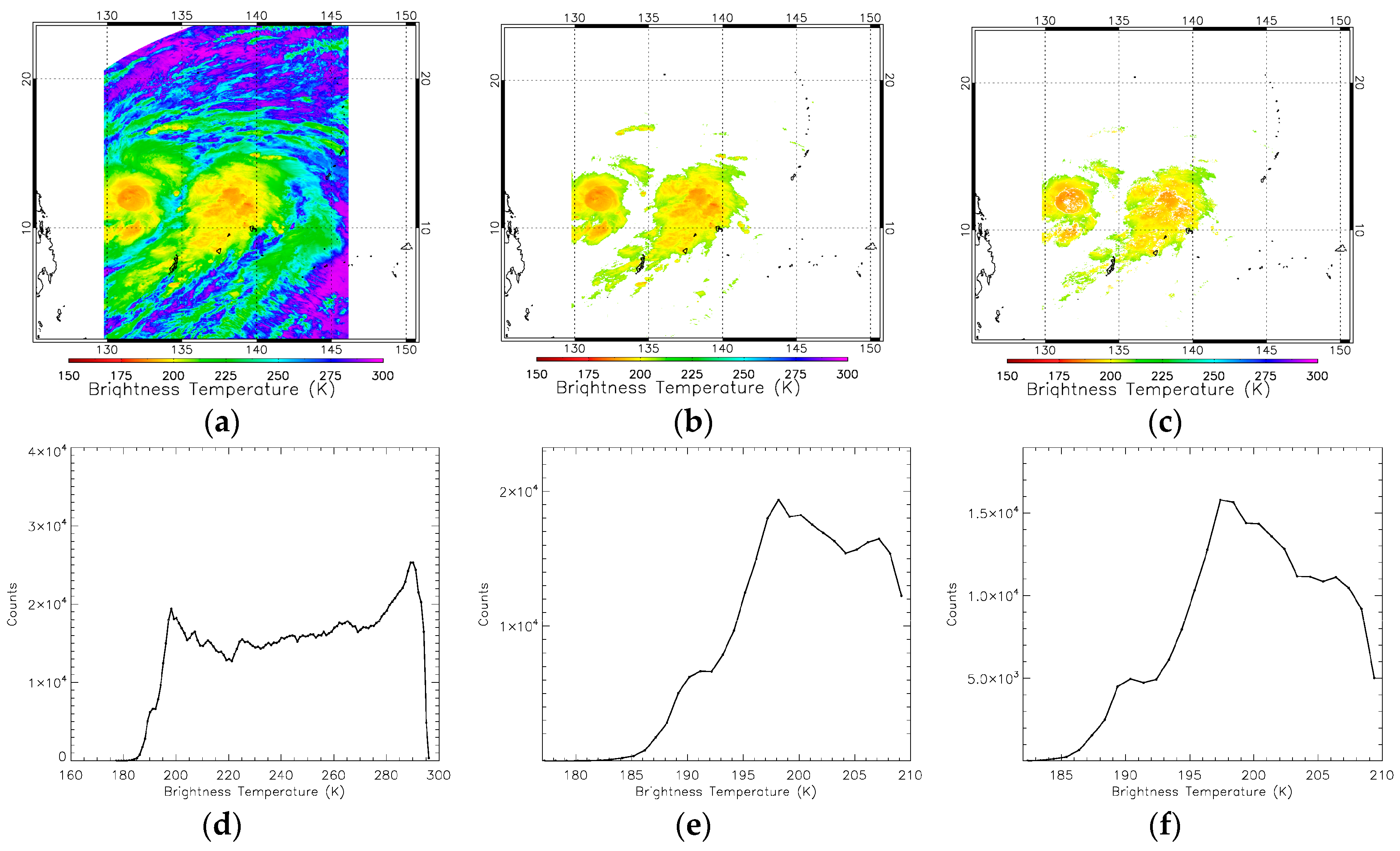
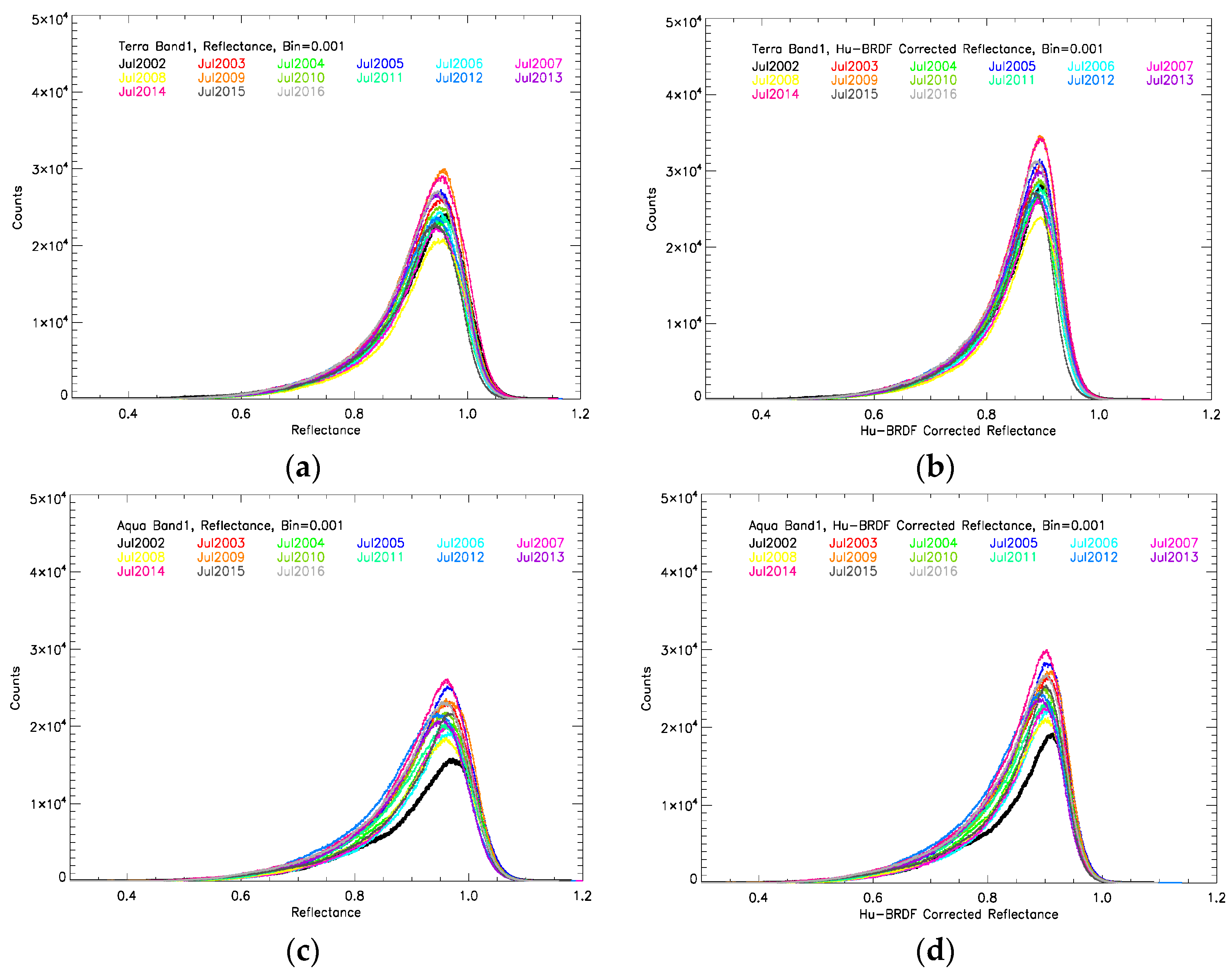
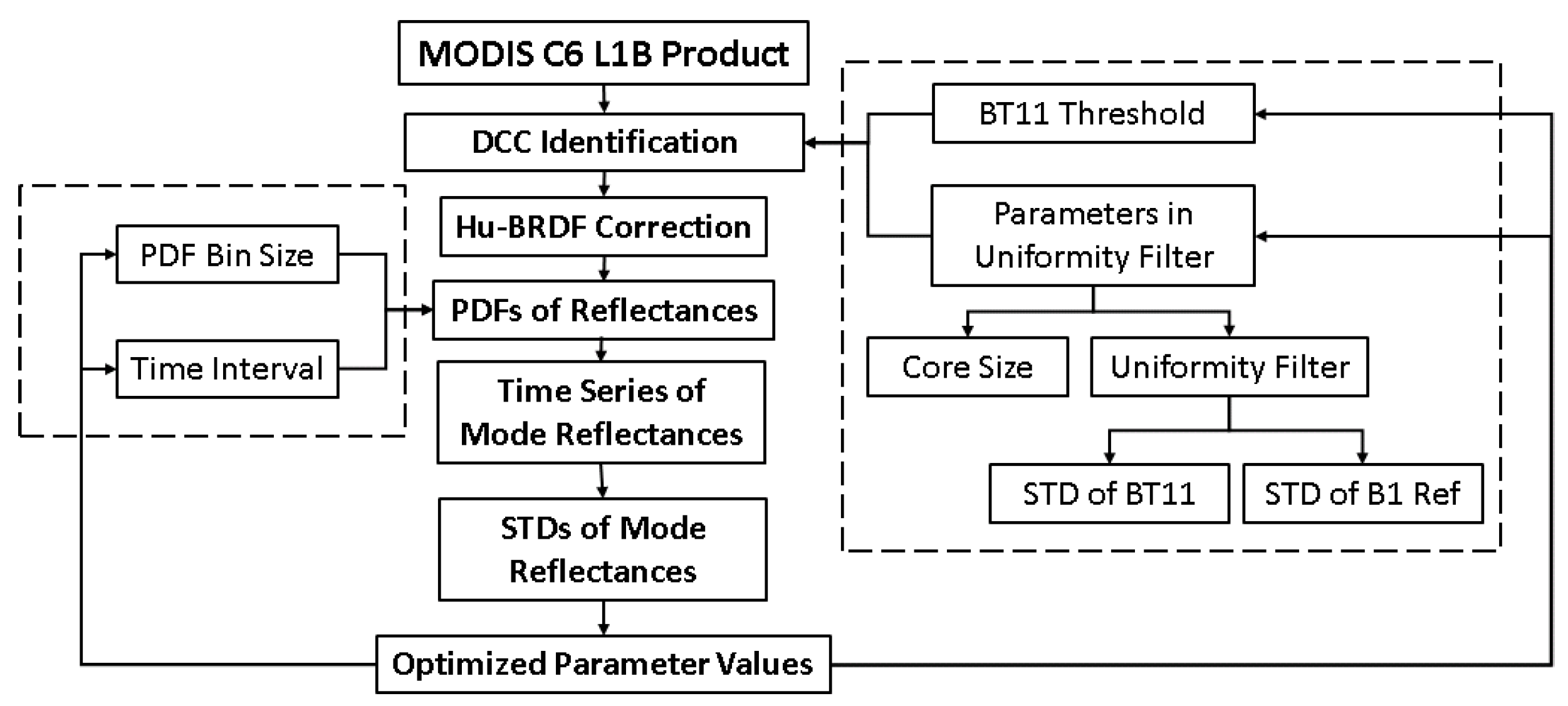
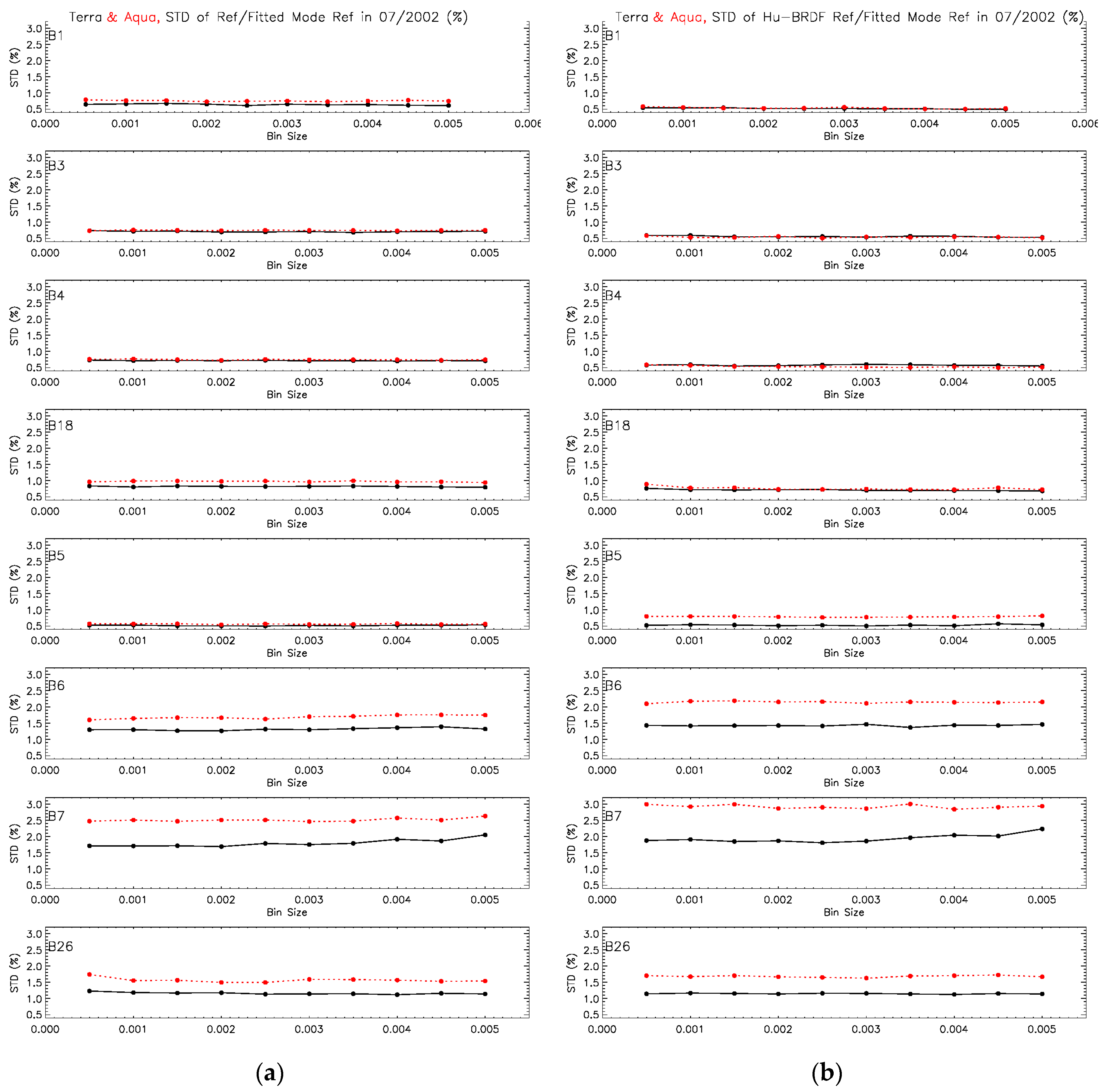
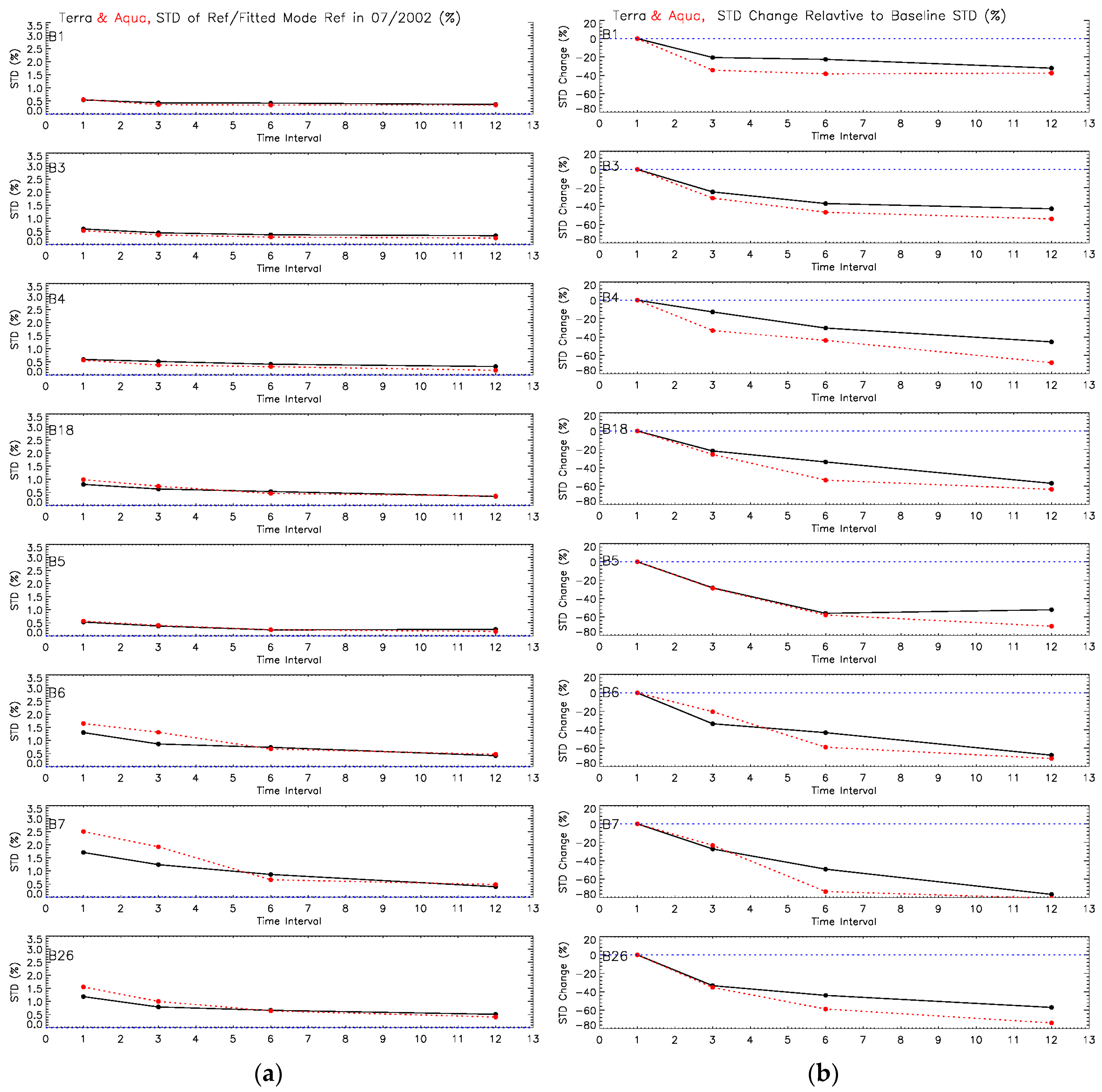
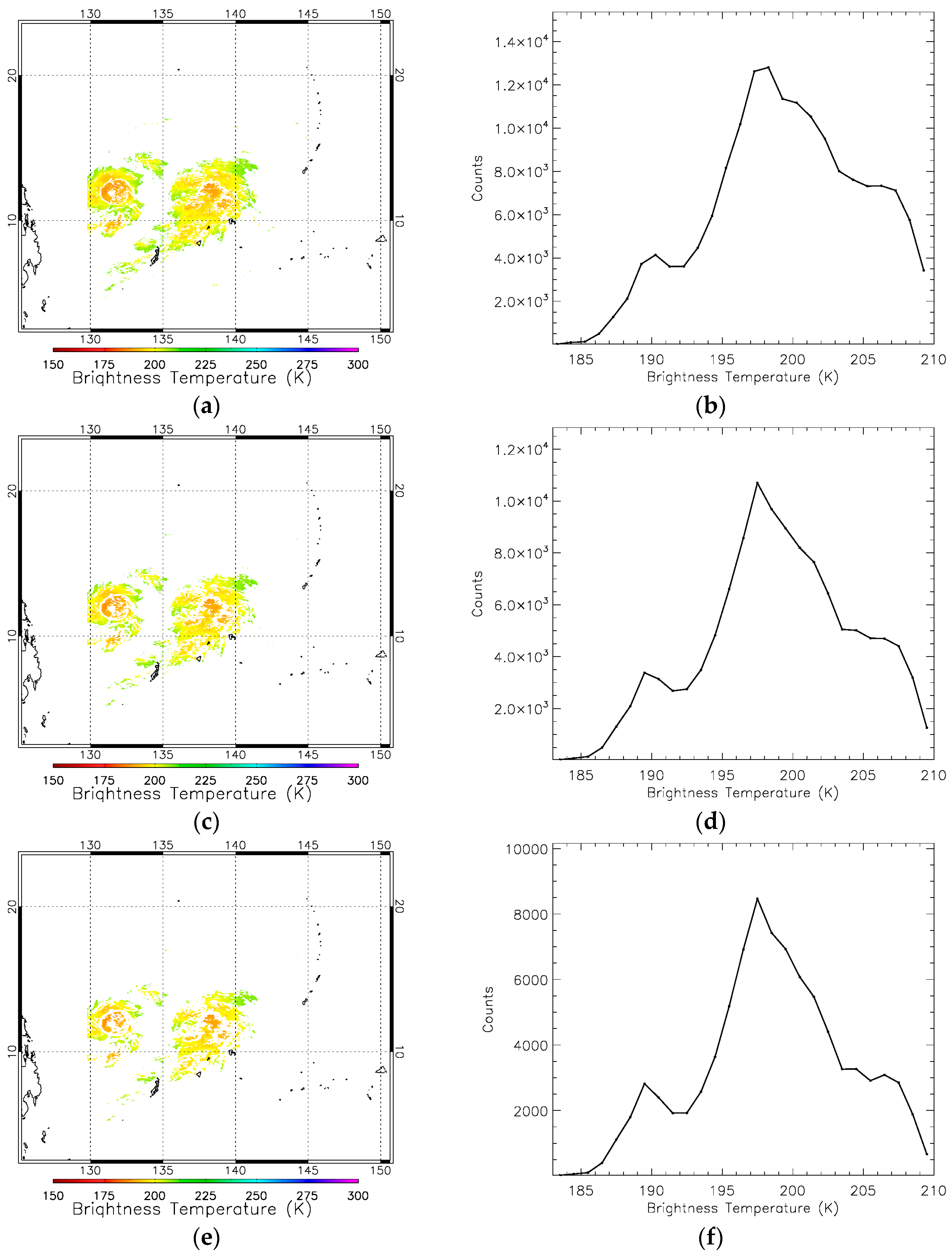
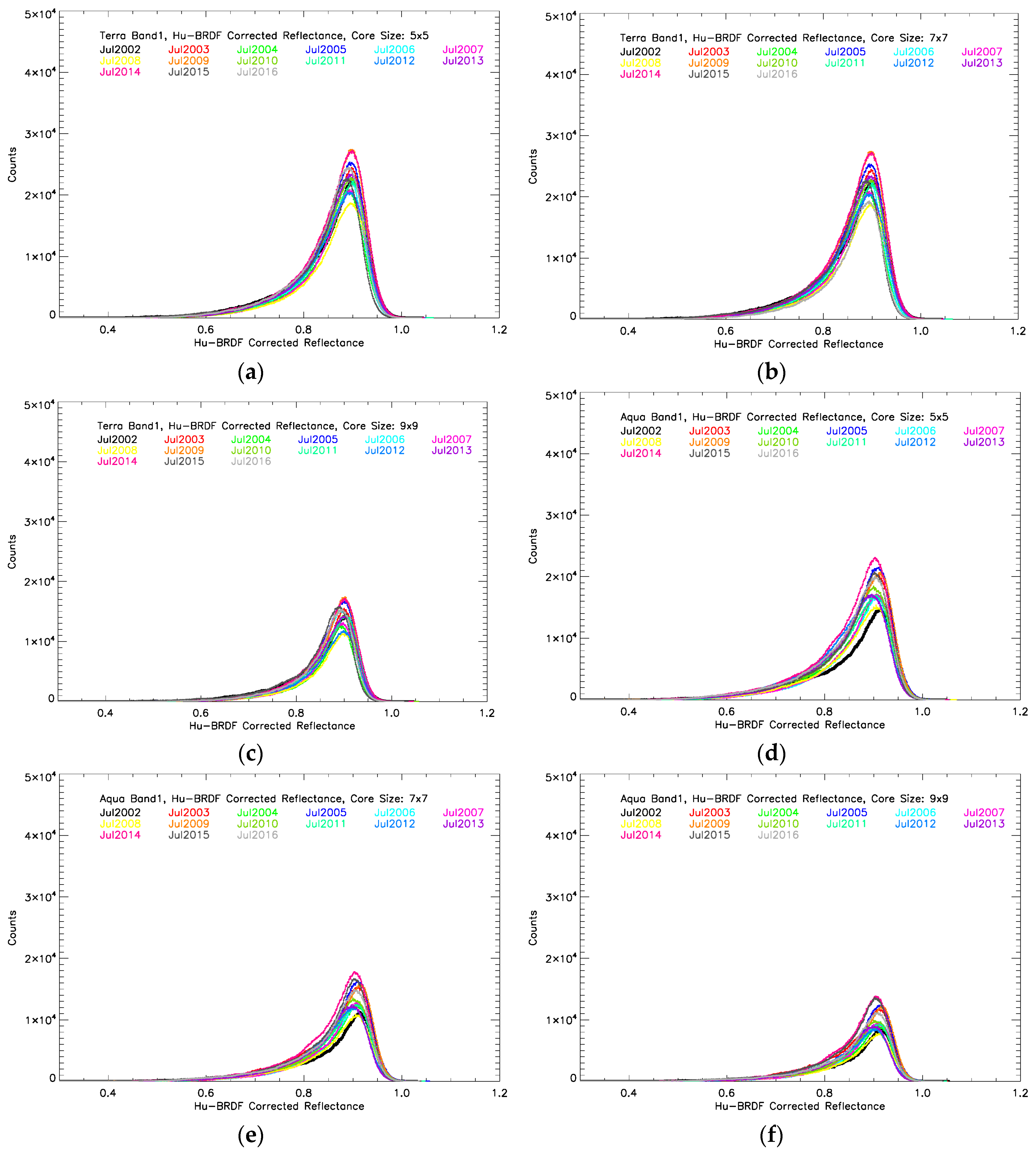
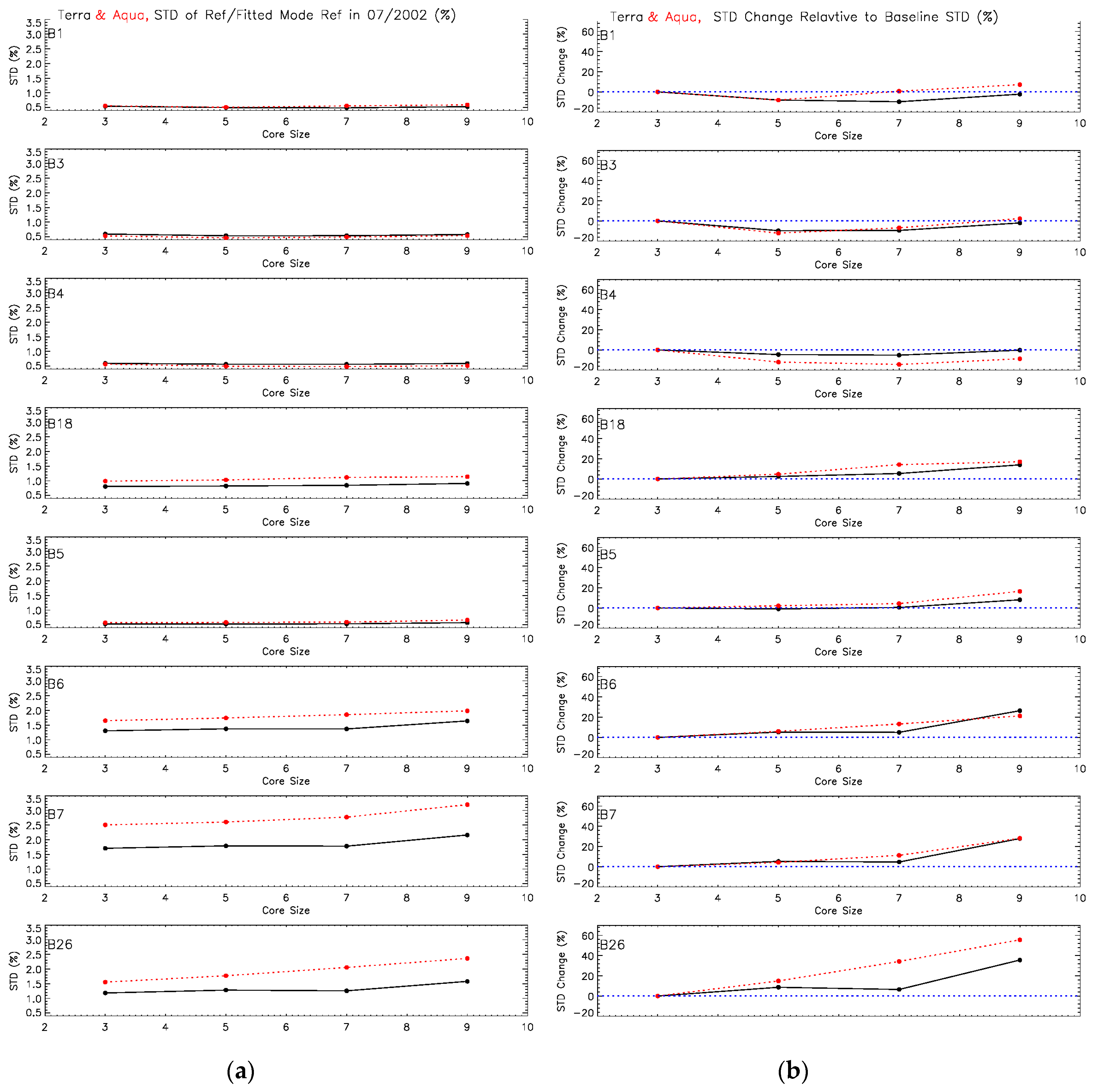
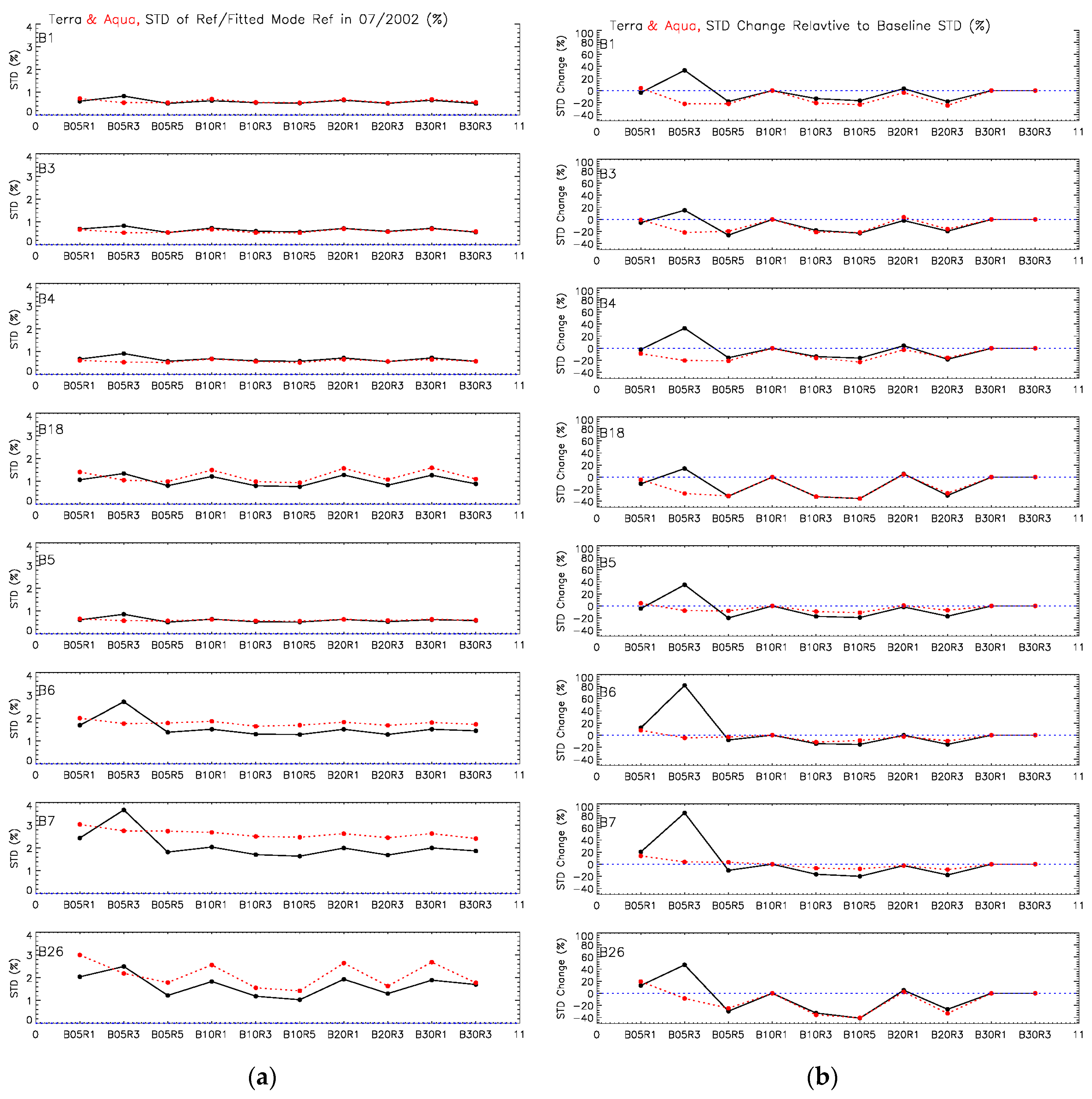
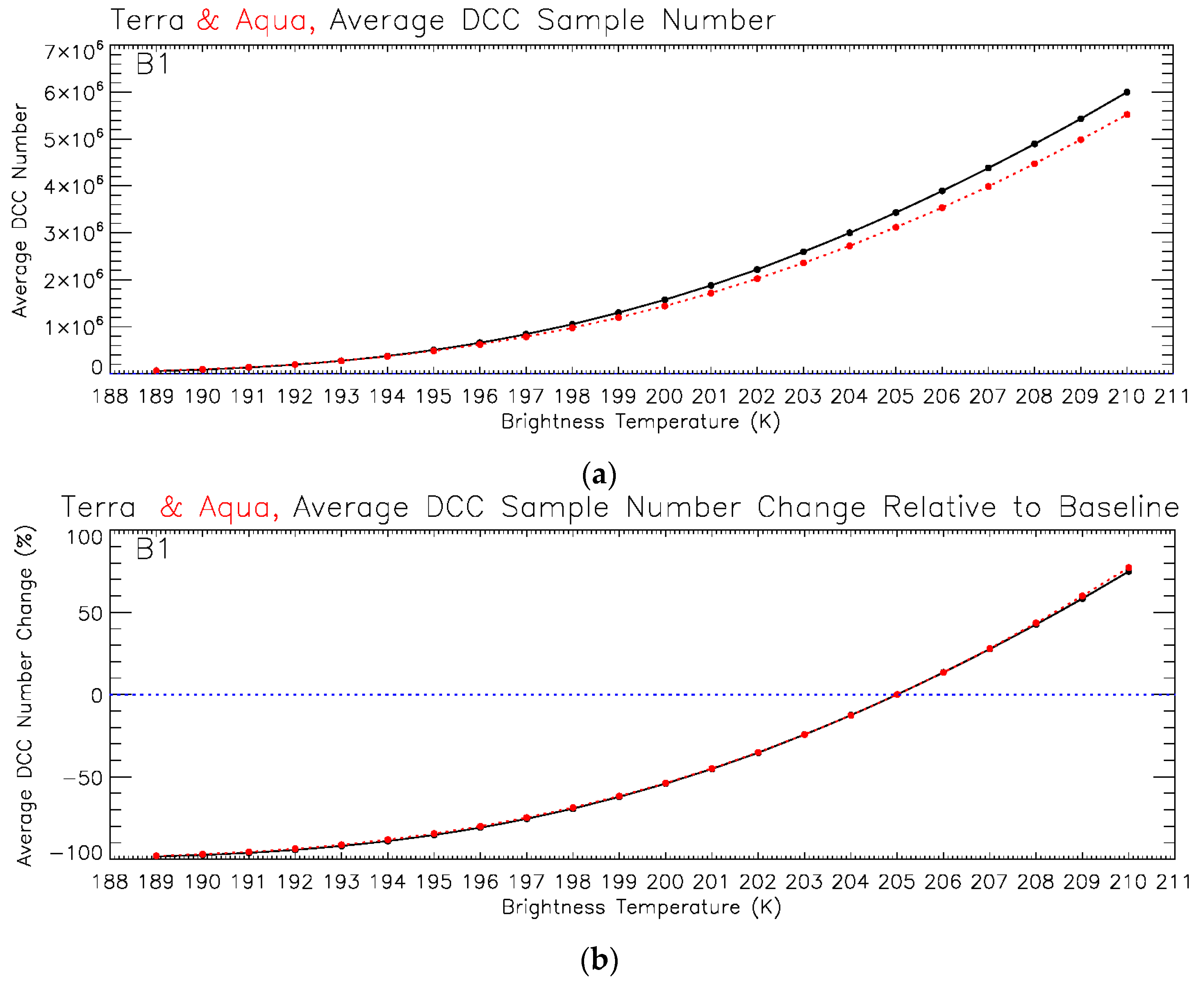

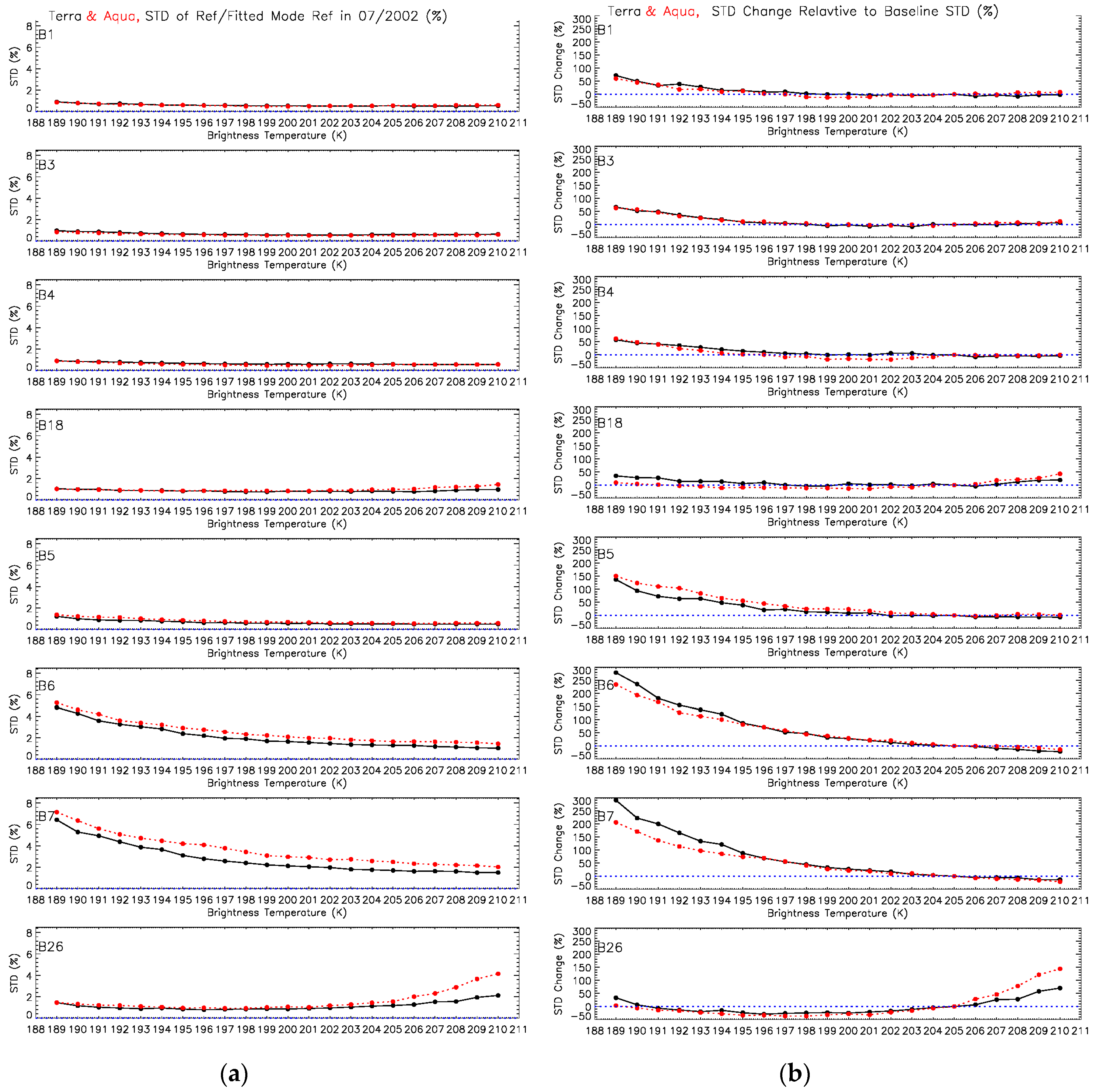
| SDSM Detector | Center Wavelength (nm) | MODIS Bands | SDSM Detector | Center Wavelength (nm) | MODIS Bands |
|---|---|---|---|---|---|
| D1 | 411.8 | 8 | D6 | 746.6 | 15 |
| 442.1 | 9 | D7 | 856.5 | 2 | |
| D2 | 465.7 | 3 | 866.3 | 16 | |
| 487.0 | 10 | D8 | 904.2 | 17 | |
| D3 | 529.7 | 11 | 935.7 | 18 | |
| 546.9 | 12 | D9 | 936.2 | 19 | |
| D4 | 553.7 | 4 | 1242.3 | 5 | |
| D5 | 646.3 | 1 | 1382.3 | 26 | |
| 665.6 | 13 | 1629.4 | 6 | ||
| 677.0 | 14 | 2114.2 | 7 |
| All Channels | BT11 Threshold (K) | Uniformity Filter Thresholds | PDF Bin (Ref) | Time Interval (Month) | BRDF | ||
|---|---|---|---|---|---|---|---|
| BT11 (K) | Ref STD (%) | Extent (Pixel × Pixel) | |||||
| Baseline DCCT | 205 | 1 | 3 | 3 × 3 | 0.001 | 1 | Hu |
| Sensitivity Tests | 189–210 | 0.5–3 | 1, 3, 5 | 3 × 3, 5 × 5, 7 × 7, 9 × 9 | 0.0005–0.005 | 1, 3, 6, 12 | Hu |
| B1 | B3 | B4 | B18 | B5 | B6 | B7 | B26 | |
|---|---|---|---|---|---|---|---|---|
| Terra | 3 | 6 | 6 | 12 | 6 | 12 | 12 | 3 |
| Aqua | 3 | 6 | 12 | 12 | 12 | 12 | 6 | 12 |
| Terra BT11 | Aqua BT11 | Terra and Aqua BT11 | |
|---|---|---|---|
| B1 | 198–210 | 198–210 | 198–210 |
| B3 | 195–210 | 195–210 | 195–210 |
| B4 | 197–210 | 197–210 | 197–210 |
| B18 | 197–206 | 189–206 | 197–206 |
| B5 | 202–210 | 202–210 | 202–210 |
| B6 | 203–210 | 203–210 | 203–210 |
| B7 | 203–210 | 203–210 | 203–210 |
| B26 | 190–206 | 189–205 | 190–205 |
| All | 203–206 | 203–205 | 203–205 |
| Baseline DCCT | BT Threshold (K) | Uniformity Filter Thresholds | PDF Bin (Ref) | Time Interval | BRDF | ||
|---|---|---|---|---|---|---|---|
| BT11 (K) | Ref (%) | Extent (Pixel × Pixel) | |||||
| B1 | 205 | 1 | 3, 5 | 5 × 5 | 0.002 | monthly | Hu |
| B3 | 205 | 1 | 3, 5 | 5 × 5 | 0.002 | monthly | Hu |
| B4 | 205 | 1 | 3, 5 | 5 × 5 | 0.002 | monthly | Hu |
| B18 | 205 | 1 | 3, 5 | 5 × 5 | 0.002 | Monthly | Hu |
| B5 | 205 | 1 | 3, 5 | 3 × 3 | 0.002 | Monthly | none |
| B6 | 205 | 1 | 3, 5 | 3 × 3 | 0.001 | monthly | none |
| B7 | 205 | 1 | 3, 5 | 3 × 3 | 0.001 | monthly | none |
| B26 | 205 | 1 | 3, 5 | 3 × 3 | 0.002 | monthly | none |
| Terra | Band | Aqua | ||||||
|---|---|---|---|---|---|---|---|---|
| DCCT | O-DCCT | Libya-4 | Dome-C | DCCT | O-DCCT | Libya-4 | Dome-C | |
| 0.54 | 0.50 | 1.15 | 2.59 | B1 | 0.56 | 0.49 | 1.00 | 2.15 |
| 0.59 | 0.51 | 1.51 | 1.70 | B3 | 0.53 | 0.45 | 1.74 | 1.22 |
| 0.59 | 0.59 | 1.15 | 2.72 | B4 | 0.57 | 0.47 | 1.33 | 2.34 |
| 0.72 | 0.67 | B18 | 0.77 | 0.78 | ||||
| 0.52 | 0.51 | 0.92 | B5 | 0.58 | 0.54 | 0.87 | ||
| 1.37 | 1.30 | 1.00 | B6 | 1.74 | 1.64 | |||
| 1.79 | 1.70 | 2.33 | B7 | 2.60 | 2.50 | 1.85 | ||
| 1.28 | 1.18 | B26 | 1.77 | 1.50 | ||||
© 2017 by the authors. Licensee MDPI, Basel, Switzerland. This article is an open access article distributed under the terms and conditions of the Creative Commons Attribution (CC BY) license (http://creativecommons.org/licenses/by/4.0/).
Share and Cite
Mu, Q.; Wu, A.; Xiong, X.; Doelling, D.R.; Angal, A.; Chang, T.; Bhatt, R. Optimization of a Deep Convective Cloud Technique in Evaluating the Long-Term Radiometric Stability of MODIS Reflective Solar Bands. Remote Sens. 2017, 9, 535. https://doi.org/10.3390/rs9060535
Mu Q, Wu A, Xiong X, Doelling DR, Angal A, Chang T, Bhatt R. Optimization of a Deep Convective Cloud Technique in Evaluating the Long-Term Radiometric Stability of MODIS Reflective Solar Bands. Remote Sensing. 2017; 9(6):535. https://doi.org/10.3390/rs9060535
Chicago/Turabian StyleMu, Qiaozhen, Aisheng Wu, Xiaoxiong Xiong, David R. Doelling, Amit Angal, Tiejun Chang, and Rajendra Bhatt. 2017. "Optimization of a Deep Convective Cloud Technique in Evaluating the Long-Term Radiometric Stability of MODIS Reflective Solar Bands" Remote Sensing 9, no. 6: 535. https://doi.org/10.3390/rs9060535
APA StyleMu, Q., Wu, A., Xiong, X., Doelling, D. R., Angal, A., Chang, T., & Bhatt, R. (2017). Optimization of a Deep Convective Cloud Technique in Evaluating the Long-Term Radiometric Stability of MODIS Reflective Solar Bands. Remote Sensing, 9(6), 535. https://doi.org/10.3390/rs9060535





